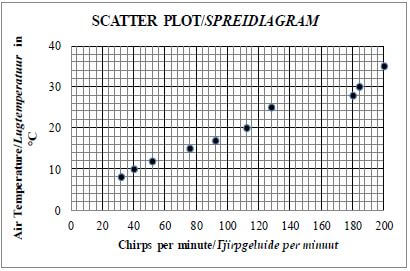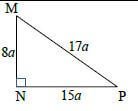MATHEMATICS PAPER 2 GRADE 12 MEMORANDUM - AMENDED SENIOR CERTIFICATE EXAMS PAST PAPERS AND MEMOS MAY/JUNE 2018
Share via Whatsapp Join our WhatsApp Group Join our Telegram GroupMATHEMATICS
PAPER 2
GRADE 12
AMENDED SENIOR CERTIFICATE EXAMS
PAST PAPERS AND MEMOS
MAY/JUNE 2018
MEMORANDUM
NOTE:
- If a candidate answers a question TWICE, only mark the FIRST attempt.
- If a candidate has crossed out an attempt of a question and not redone the question, mark the crossed out version.
- Consistent accuracy applies in ALL aspects of the marking memorandum. Stop marking at the second calculation error.
- Assuming answers/values in order to solve a problem is NOT acceptable.
GEOMETRY | |
S | A mark for a correct statement |
R | A mark for a correct reason |
S/R | Award a mark if the statement AND reason are both correct. |
QUESTION 1
110 | 112 | 156 | 164 | 167 | 169 |
171 | 176 | 192 | 228 | 278 | 360 |
1.1.1 | Mean = 2283 | ✓ sum/som |
1.1.2 | Median = 169 +171 =170 thousand rands | ✓ answer (1) |
1.2 |
| ✓ whiskers |
1.3 | IQR = Q3 − Q1 | ✓ answer (1) |
1.4 | Skewed to the right or positively skewed. | ✓ answer (1) |
1.5.1 | σ = 67,04118759 thousand rands | ✓ answer (1) |
1.5.2 | x −σ = 123,21 thousand rands | ✓ lower limit |
[11] |
QUESTION 2
CHIRPS PER MINUTE | AIR TEMPERATURE IN °C |
32 | 8 |
40 | 10 |
52 | 12 |
76 | 15 |
92 | 17 |
112 | 20 |
128 | 25 |
180 | 28 |
184 | 30 |
200 | 35 |
2.1 | SCATTER PLOT
|
|
2.2 | The points lie almost in a straight line. This suggests a very strong positive relationship between the number of chirps per minute and the temperature of the air. OR r = 0,99 so there is a very strong positive relationship between the number of chirps per minute and the temperature of the air. | ✓ justify with straight line (1) |
2.3 | a = 3,97 | ✓a = 3,97 |
2.4 | Air temperature ≈ 15,67°C (calculator) OR y ≈ 3,97 + 0,15(80) OR Air temperature ≈ 16°C (graph: Accept between 15°C and 17°C) | ✓✓ answer (2) |
[9] |
QUESTION 3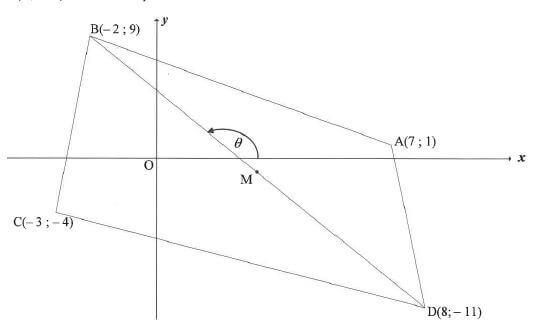
3.1 | mAC = 1−(−4) OR − 4−1 | ✓ substitution |
3.2.1 | y = 1/2x + c y - y1 = 1/2(x - x1) OR y = 1/2x + c y - y1 = 1/2(x - x1) | ✓ substitution M and A(7 ; 1) |
3.2.2 |
OR
| ✓ x coordinate ✓y coordinate ✓ x coordinate |
3.3 | mBD = 9−(−11) OR (−11) −9 | ✓ correct substitution |
3.4.1 | tanθ =mBD = −2 | ✓ tanθ = mBD |
3.4.2 | tan β = mBC OR BD = √500 ; BC = √170 & CD = √170 | ✓ mBC =13 |
3.4.3 | 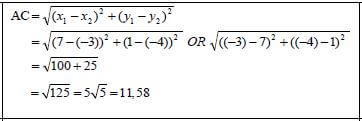 | ✓ correct substitution into distance formula |
3.4.4 |  Area of ∆ABC= 1/2base × ⊥height | ✓ correct substitution into distance formula |
[23] |
QUESTION 4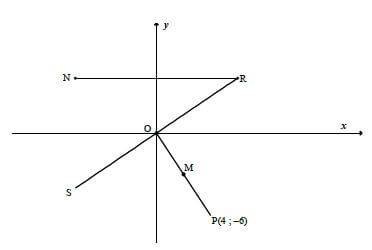
4.1 | M( 0 + 4; 0 + (-6)) | ✓ 2 |
4.2.1 | x2 +y2= 42 +(−6)2 | ✓ substitution |
4.2.2 | (x− 2)2 +(y +3)2 = (√52 )2 = 13 | ✓ substitution of M |
4.2.3 | mOP = -6 = − 3 | ✓ mOP |
4.3 | x2 + y2 = 52 and y = 2/3 x | ✓ substitution |
4.4 | Let T(x ; 0) be the other x intercept of the small circle | ✓ y = 0 |
QUESTION 5
5.1.1 | Given :sinM = 15/17 OR
| ✓ sketch or Pyth |
5.1.2 | sin M = NP NP = 15a | ✓ equating trig ratios |
5.2 | cos(x−360°).sin(90°+x +cos2(−x) −1 | ✓ cos x ✓ cos x |
5.3.1 | sin(2x + 40°)cos (x + 30°) − cos(2x + 40°) sin(x + 30°) | ✓ reduction |
5.3.2 | sin(2x + 40°) cos(x + 30°) − cos(2x + 40°) sin(x + 30°) = cos(2x − 20°) OR ∴cos(2x − 20°) = sin(x +10°) | ✓ equating |
[18] |
QUESTION 6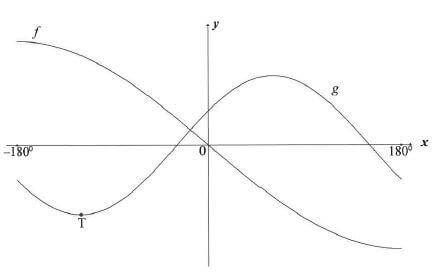
6.1 | Period = 720° | ✓ answer (1) |
6.2 | y∈[−2 ; 2] | ✓✓ answer (2) |
6.3 | f (−120°) − g(−120°) | ✓ x = −120° |
6.4.1 | x-intercepts of g at -90° + 60° = -30° and 90° + 60° = 150° OR x-intercepts of g at -90° + 60° = -30° and 90° + 60° = 150° | ✓ value |
6.4.2 | x∈[−180° ; −120°) ∪ (−30° ; 60°) ∪(150° ;180°] | ✓ [−180° ; −120°) |
[13] |
QUESTION 7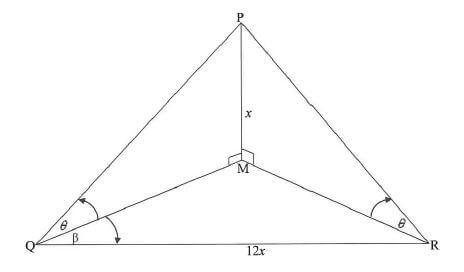
7.1 | In PMQ : tanθ = x OR | ✓ trig ratio |
7.2 | In PMR : tanθ = x OR PMQ ≡PMR [AAS/HHS] OR In PMR : tanθ = x OR PMQ = PMR[AAS/HHS] | ✓ MR = QM |
7.3 | x = cos β [both equal tan θ ] | ✓ equating |
[9] |
QUESTION 8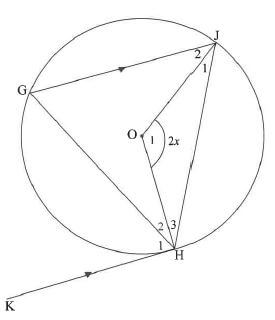
8.1.1 | G = x [∠ centre = 2× circumference ] | ✓S ✓R |
8.1.2 | Ĵ + ˆH3 =180°−2x [sum of ∠s in ∆ ] OR H2 = 90° - x | ✓S |
8.2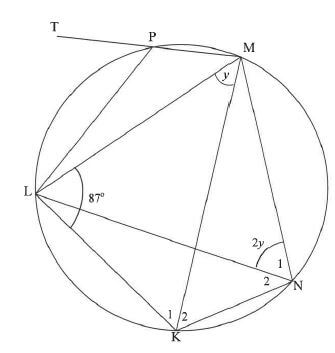
8.2.1 | N2 = y [∠s in the same seg ] | ✓S ✓R (2) |
8.2.2(a) | 2y + y +87° = 180° [opp ∠s of cyclic quad] | ✓S ✓R |
8.2.2(b) | TPL = 62° [ext. ∠ of cyclic quad] | ✓S ✓R (2) |
[15] |
QUESTION 9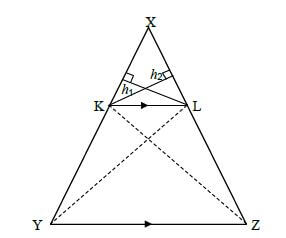
9.1 | Constr: Join KZ and LY and draw h1 from K ⊥ XL and h2 from L ⊥ XK area ∆XKL = ½XK×h1 | ✓ constr ✓ area ∆XKL |
9.2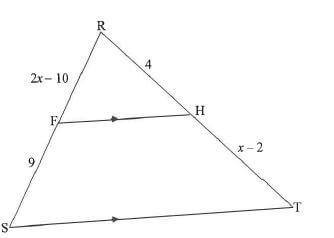
9.2.1 | RH RF = [line || one side of ∆ OR prop theorem; FH || ST] FS HT [Lyn || een sy van ∆ OF eweredigh. st; FH|| ST] 2x −10 4 = 9 x − 2 (2x −10)(x − 2) = 4×9 2 2x −14x −16 = 0 2 x − 7x −8 = 0 (x −8)(x +1) = 0 ∴x =8 (x ≠ -1) OR/OF RF RH = [line || one side of ∆ OR prop theorem; FH || ST] RS RT [Lyn || een sy van ∆ OF eweredigh. st; FH|| ST] 2x −10 4 = 2x −1 x + 2 (2x −10)(x + 2) = 4(2x −1) 2 2x −14x −16 = 0 2 x − 7x −8 = 0 (x −8)(x +1) = 0 ∴x =8 (x ≠ -1) | ✓S/R | |
9.2.2 | 1 RF×RH sinˆ area ∆RFH 2 = area ∆RST 1 RS×RT sinˆ 2 1 ˆ ×6×4×sin = 2 1×15×10×sin ˆ 2 24 4 = = 150 25 | ✓ numerator | |
[14] | |||
QUESTION 10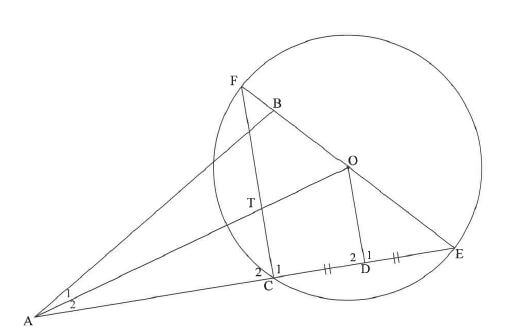
10.1.1 | C1 = 90° [∠ in semi circle ] OR FO = OE [radii] | ✓ S ✓ R ✓ S ✓ R |
10.1.2 | DÔE = F [corresp ∠s =; FC || OD] | ✓ S ✓ R |
10.1.3 | In ∆ABE and ∆FCE: | ✓ S |
OR
∆ODE ||| ∆ABE (∠∠∠) | ✓ S | |
10.2 | AT = AC = 3 [line || one side of ∆ OR prop theorem; FC || OD] | ✓ S ✓ R
|
[21] |
TOTAL: 150
MATHEMATICS PAPER 2:JUNE 2018
MARKING GUIDELINES NOTES
QUESTION 1
1.1.1 If left as 190, 25 then penalise 1 mark.
1.1.2 If the position is used:![]()
= 158+219
2
= 377
2
= 188,5
QUESTION 2
2.4 Do not accept estimation from the table.
QUESTION 3
3.1 | No ca if x2 −x1 | |
3.3 | MD2 +AM2 | ✓ AM2 + MD2 |
QUESTION 4
4.3 Candidates can use the rotation of P through 90° to get to R(6 ; 4) If the candidate assumes that R(4 ; 6) : 1/4 marks
QUESTION 6
6.2
- y∈(−2 ; 2) 1/2 marks
−2 < y < 2 1/2 marks
QUESTION 7
7.3 There is NO penalty for incorrect rounding.
QUESTION 9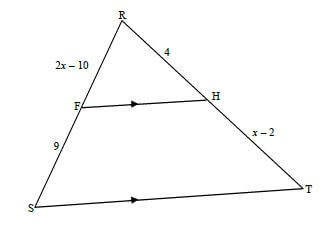
9.2.2
- Join FT.
area ∆RFH = 4/10 × (area ∆RFT)
But area ∆RFT = 6/15 × (area ∆RST) (common vertex; = heights)
area ∆RFH = 4/10 × 6/15 × areaΔRST
areaΔRFH = 4
areaΔRST 25

